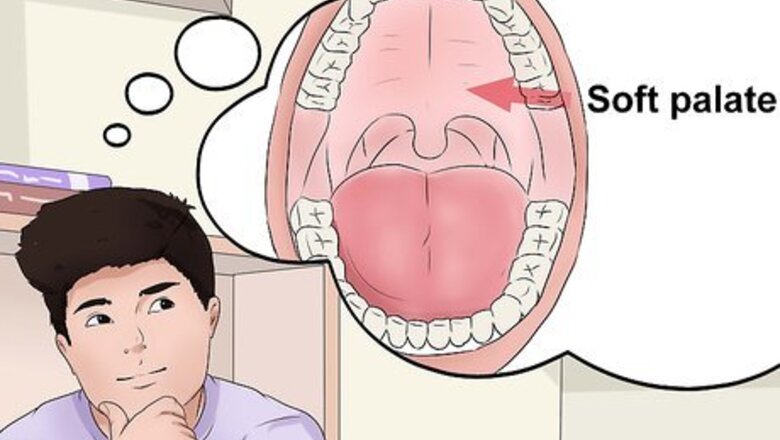
views
Lifting Your Soft Palate
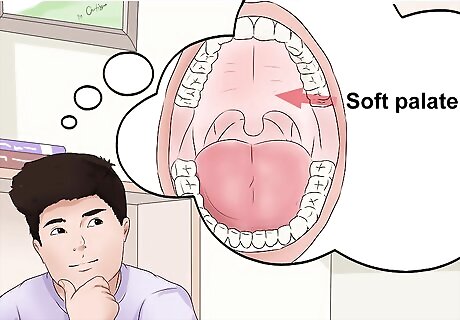
Identify your soft palate. The roof of your mouth is made up of a hard palate and a soft palate. If you touch it with your tongue, you can identify. The hard palate stays in place. This is what's thought of as the roof of your mouth. It's the part of your mouth made of bone and covered with skin. It's encased between your teeth and attached to your skull. Further back in your mouth is the softer, fleshier area of the soft palate. It can move up and down when you touch your tongue to it and it moves and stretches up whenever you speak, eat, yawn—basically anytime you use your mouth. Lifting your soft palate is key to controlling your voice, and can help you prevent singing through your nose. Expert Answer Q A wikiHow reader asked: "Is singing through your nose bad?" Annabeth Novitzki Annabeth Novitzki Music Teacher Annabeth Novitzki is a Private Music Teacher in Austin, Texas. She received her BFA in Vocal Performance from Carnegie Mellon University in 2004 and her Master of Music in Vocal Performance from the University of Memphis in 2012. She has been teaching music lessons since 2004. Annabeth Novitzki EXPERT ADVICE Answer from Annabeth Novitzki: Annabeth Novitzki, a private voice teacher, responds: "No, singing through your nose is not bad and it won't hurt you. However, most people don't prefer nasal singing because it limits the beauty and tone of the sound."
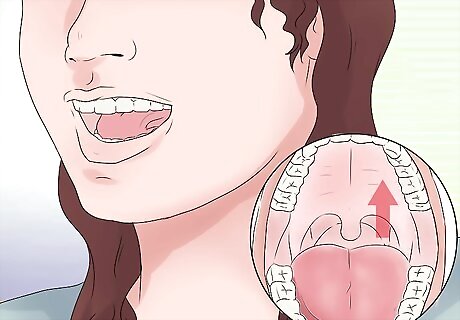
Practice lifting your soft palate. Imagine there is a ping-pong ball in the back of your mouth. You would need to have your soft palate lifted if there were an object back there taking up space. Alternatively, you can do a half yawn. Notice that you lift or stretch your soft palate upward while you do this. Practicing this will familiarize you with the feeling of lifting your soft palate. You can also practice inhaling a soft K sound. This will naturally lift your soft palate, just slightly, so it is not as dramatic as the lift would be if you had a ping-pong ball in your mouth.
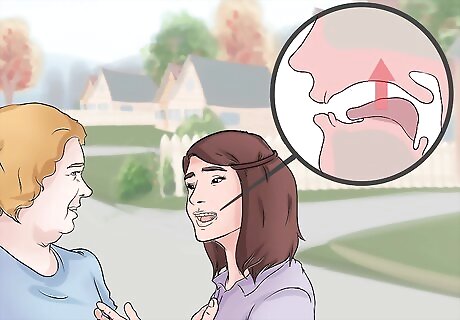
Practice talking with your soft palate raised. Raise your soft palate and speak. You can try talking to yourself or doing something like reading a book out loud with your soft palate raised. It may feel and sound silly, but you will train yourself to be able to lift the soft palate on demand. This can also help you learn how to make noise with your mouth while raising your soft palate.
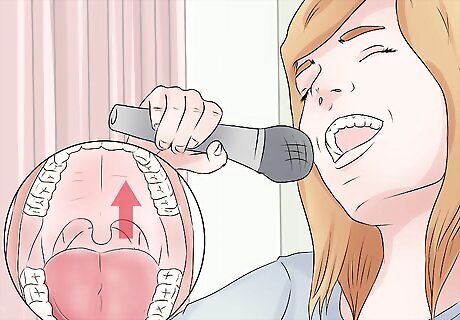
Practice singing with your soft palate raised. Once you are rather comfortable talking with your soft palate raised, practice singing. You should notice a difference in the tone of your voice. Raising the soft palate creates more room for your voice to resonate in your mouth, giving it a richer tone. You may want to compare the sound to the sound you make when you were singing through your nose by first singing like you used to, with your soft palate lowered, and then singing with your palate raised. It’ll be easier to hear the improvement. Aim to find the "sweet spot" between raising and lowering your soft palate to create the best sound. Note that you'll need to raise your soft palate higher for high notes than lower notes.
Practicing Vocal Techniques
Practice good breath support. Nasal singing is often a result of an under-supported voice. Aim to breathe deeply from your diaphragm (your lower lungs). Imagine that there's a rubber ring around your waist where your diaphragm is and try to push the ring outward as you inhale. However, be sure to avoid raising your shoulders as you breathe in. Keep them relaxed and level. Breathe in through your nose and breathe out through your nose and your mouth.
Do lip trills to warm up. It's important to warm up your voice before you begin singing. Practice lip trills, hum, and sing scales and arpeggios to get your voice ready for a performance or practice session. These exercises also encourage airflow, which can prevent you from having a nasally tone.
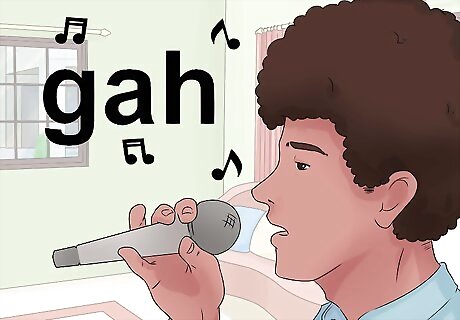
Replace the lyrics of your song with “gah.” This vocal exercise can help get rid of nasal singing. The sound “g” will naturally move your voice further down, adding richness to your tone and bringing it away from the nose. The “ah” makes you drop your jaw and your tongue, which will also add depth to your tone. Try singing your song, but replacing the words with "gah." Simply keep making the noise "gah" while following the tune of a song. Keep your jaw relaxed as you do this to prevent strain. Once you’ve practiced your song with “gah” sound, try to incorporate the lyrics back in. You may notice you sound less nasally. If you struggle with sounding nasal at particular places in the song, you can always begin your practice by singing “gah” on those parts of the song before adding the lyrics back in.

Plug your nose while you sing. If you are singing through your nose, this will exacerbate the nasal quality. You may sound more nasally when singing through your nose. However, this method will block the nasal passage so you will have to figure out how to sing through your mouth, rather than your nose. This can help your singing down the road. You may sound less nasally once you have experience singing without being able to channel air through your nose.

Adopt a pleasant expression when you sing. You should strive to sing with your throat open, as this raises your soft palate and can therefore prevent nasally singing. One way to achieve an open throat is to sing with a pleasant expression as this will naturally lift up your throat. Do not attempt to smile, as this can look unnatural. Instead, gently lift up your cheeks. You can do so by slightly lifting the zygomatic muscles. These are the muscles on the side of the mouth you would lift when smiling. During speech and singing, many people have a tendency to pull their facial muscles down slightly. By adopting a pleasant expression when singing, you can combat this tendency. This can create an open throat, making nasally singing less likely.

Find a voice teacher. There are some incredible voice teachers out there, who are experts in the field and can help you on your path to singing without sounding nasally. If you walk through vocal techniques with a voice teacher, he or she can provide more specifics based on your personal style and skill set. Look online or in the local yellow pages to find a voice teacher in your area. You can also ask your choir director or musicians you know to refer you to a voice teacher.
Improving Your Posture
Practice singing while standing against a wall. Until the proper posture is second nature to you, you can practice singing while standing up against a wall. Keep your heels, calves, buttocks, shoulders, and head against the wall to ensure your entire body is aligned.

Keep your back straight and shoulders down. This will help you keep your chest lifted, which can help improve the sound of your singing. Allowing air to more easily travel through your lungs can help you sing with your chest and mouth rather than through your nose. The shoulders should not be shoved back, just slightly back so you are not hunching forward.
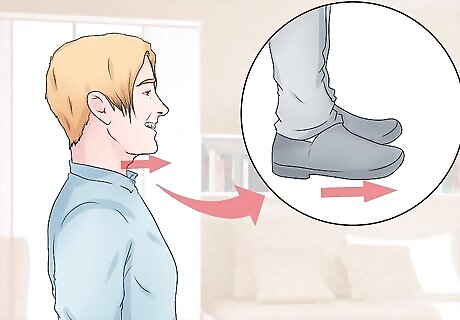
Make sure your chin is parallel to the floor. You can use a mirror to check that your chin isn’t raised or tucked in too far.
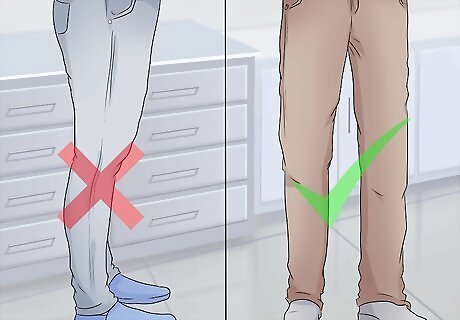
Do not lock your knees. Even if you’re nervous, it’s very important that you keep your knees loose. Locked knees can block some of the veins necessary to get blood to the heart. You could end up losing consciousness.

Stay relaxed. Keep your neck muscles and shoulders loose. If you’ve had to correct your posture significantly, these new positions will feel uncomfortable for a little while. It may be difficult to relax and loosen up at first. However, keep practicing. A new posture should feel better over time as your body gets used to it.

Engage your abdominal muscles. You want to make sure that you are engaging your core, but that you are not stiff. Channel your breath through your abdomen when you're singing. Try placing one hand on your abdomen. As you breathe, make sure that your abdomen is expanding when you breathe in. This means that it is relaxed.



















Comments
0 comment